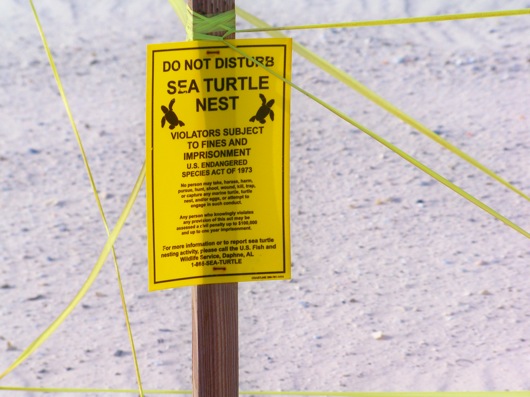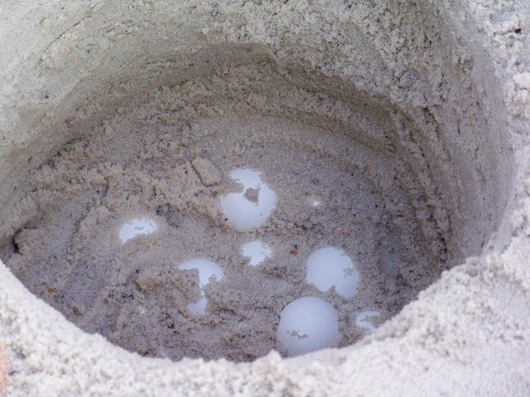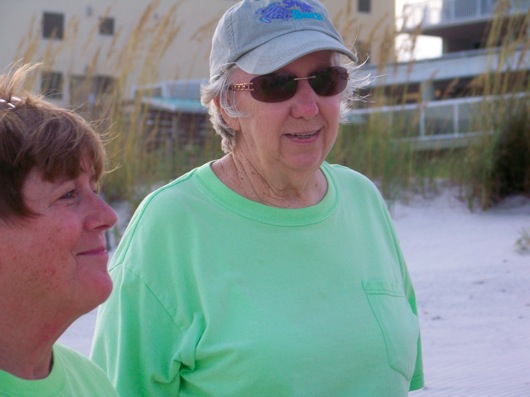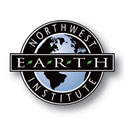Precious Cargo
Towards the end of our trip, I held the fate of 42 members of an endangered species in my hands. Literally.
In an effort to save endangered sea turtles from the Deep Horizon spill, the U.S. Fish and Wildlife Service has implemented a massive turtle egg relocation initiative. Share the Beach is a key partner. Share the Beach is a non-profit organization that uses more than 300 volunteers to patrol all 47 miles of Alabama’s coastline daily during turtle nesting season. Mike Reynolds, self-proclaimed “Turtle Czar,” leads the effort.
Six members of our PDX 2 Gulf Coast team had been invited to observe and document a turtle egg relocation. We met Mike and his team on a beach in Gulf Shores Alabama at 5:15 p.m.
From a distance the beach looked clean, stretching long and white in both directions. However, once on the sand it was easy to see that the entire beach was covered with tar balls. They were dark brown, roundish gobs of oil covered with sand. Pressing them between my fingers brought out the reek of oil. It was clear that the beach was still heavily oiled with more oil coming ashore. I looked out at the water and wondered about dispersants and submerged oil just beneath the surface.
Tourists swam in the surf and basked in the sun. Children played in the sand. All immersed in, and surrounded by, oil.
On a higher portion of the beach, near the towering hotel, was a taped off area approximately 15 square feet in size. Inside was a smaller taped off square with a sign that read, “Turtle Nesting Site.”
Forty-two nights earlier, a three foot wide loggerhead turtle had dragged herself up onto the sand, labored to dig a flat, deep, round hole and deposited into it 122 ping-pong ball sized eggs. She then covered the nest and returned to the oiled water.
The Share the Beach volunteer patrol had witnessed this activity and marked the nest site. The original nest had been laid too close to the ocean’s edge and the eggs were at risk of drowning so the crew had moved the eggs further up on the beach, to higher ground,.
Now, the eggs had hardened and it was time to move them again. The team was there to collect the eggs and ship them via Federal Express to a climate controlled hangar at the Kennedy Space Station on Cape Canaveral. Once hatched they would be released at the Canaveral National Seashore on the Central Florida Coast.
Heading into this experience I hadn’t expected to be removing eggs in the midst of sunbathers and sand-covered children. Adding to the surreal strangeness of the setting were several small planes repeatedly flying over the beach trailing advertisement banners. One read, “Doc’s thank you for visiting our beaches.” Yes, it did actually have the typo as printed here. To top it off, just down the beach a hired crew was attempting to clean oil from the sand. Their tools were nothing more than long-handled mesh nets similar to nets used to skim leaves from a swimming pool. They scooped along the beach, capturing gooey balls of tar and dumping them into five gallon buckets.
I was reminded of little boys playing in a toxic sandbox. We have deployed technologies to tap oil 5,000 feet below the surface of the ocean but have nothing more than human muscle and primitive tools to clean up the aftermath.
The turtle removal was similarly low-tech and painstaking. Kneeling beside the nest, wearing surgical gloves to protect himself from oil and dispersants, Mike began using his large hands, like turtle flippers, to excavate the nest. After ten minutes of gentle digging and clearing, the first eggs were unearthed, bright white against the dark sand. Mike used a green sharpie to make a slash mark on each egg, indicating which end was up and the direction it was facing.
Over the next hour and a half, each egg was carefully lifted and placed into one of three small Styrofoam coolers in the same orientation as it was removed from the nest. Mike’s crew of trained volunteers consisted mostly of silver-haired senior ladies, all members of the Share the Beach group that keeps guard over this section of the beach. These ladies love “their babies.”
A woman named Peggy told me, “I’ve been doing this for six years and each time you see the little ones come crawling up out of the sand it just gets you in your heart.”
One of the big unknowns in this unprecedented egg relocation effort is the effect it will have on the homing instinct. At about 15 years of age, the female sea turtles reach sexual maturity, mate and head toward the very beach upon which they had been hatched years before. The exact method of their extraordinary homing beacon is not thoroughly understood. There is no way to know if the hatchlings that survive this relocation project will know how to return to the Gulf Shores region.
As the ladies placed them into the nest boxes they softly chanted, “Gulf Shores. Gulf Shores. Come back little ones.” The scene struck me as simultaneously beautiful, sad and absurd. We were a group of a dozen or so people, all volunteers, taking personal action to help these amazing wild creatures. The sense of excitement, care and even love was palpable. Passing tourists stopped to see what was going on and stayed rapt, amazed, encouraged. And yet, it is only because human activity has so degraded turtle habitat that the undertaking was necessary in the first place.
Loggerhead turtles are the most abundant of all the marine turtle species in U.S. waters. But persistent population declines due to pollution, shrimp trawling, and development in their nesting areas, among other factors, have kept this wide-ranging seagoer on the threatened species list since 1978. In Gulf Shores over the past decade, the Share the Beach volunteers have been kept busy trying to shield the hatchlings from the lights of the tall hotels, which confuses them and draw them away for the ocean. Their habitat is so degraded they required human intervention long before the Deep Horizon spill.
Filled with eggs, the boxes were strapped to frames by shock-absorbing rubber bungee cords. Two people carried each box toward an awaiting vehicle. Tourists walked along with us watching the process. Mike, looked over at me and said, “Well, at least a lot more people are now aware of the plight of the sea turtle.” I nodded and said, “That is the only thing that makes any sense of this.”
A powerful sense of responsibility and awe washed over me. I held in my hands 42 members of a species that is disappearing from the Earth. I walked very carefully and held very tightly to my precious cargo.
By Cylvia Hayes, 3EStrategies


























1 COMMENT
Another great post Cylvia, thanks!
Leave a comment